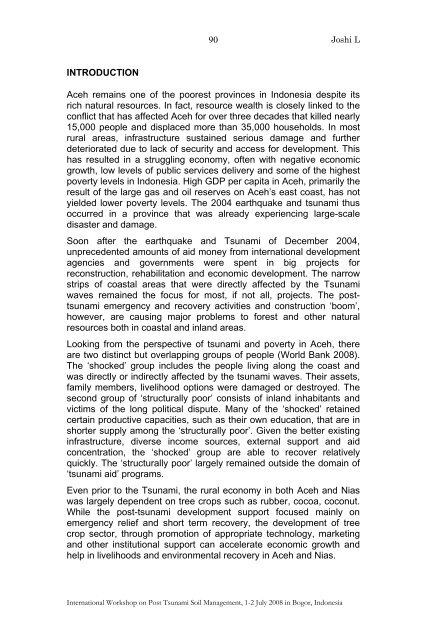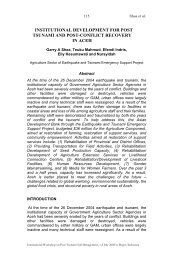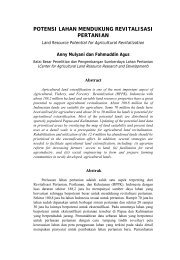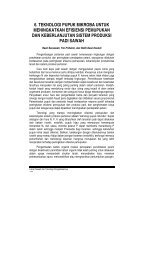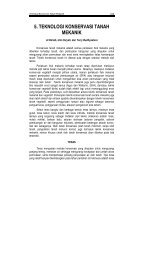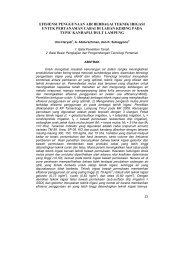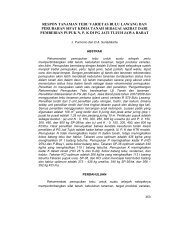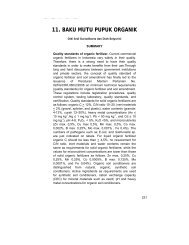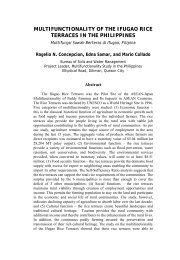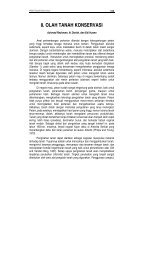Proceedings - Balai Penelitian Tanah
Proceedings - Balai Penelitian Tanah
Proceedings - Balai Penelitian Tanah
You also want an ePaper? Increase the reach of your titles
YUMPU automatically turns print PDFs into web optimized ePapers that Google loves.
INTRODUCTION<br />
90<br />
Joshi L<br />
Aceh remains one of the poorest provinces in Indonesia despite its<br />
rich natural resources. In fact, resource wealth is closely linked to the<br />
conflict that has affected Aceh for over three decades that killed nearly<br />
15,000 people and displaced more than 35,000 households. In most<br />
rural areas, infrastructure sustained serious damage and further<br />
deteriorated due to lack of security and access for development. This<br />
has resulted in a struggling economy, often with negative economic<br />
growth, low levels of public services delivery and some of the highest<br />
poverty levels in Indonesia. High GDP per capita in Aceh, primarily the<br />
result of the large gas and oil reserves on Aceh’s east coast, has not<br />
yielded lower poverty levels. The 2004 earthquake and tsunami thus<br />
occurred in a province that was already experiencing large-scale<br />
disaster and damage.<br />
Soon after the earthquake and Tsunami of December 2004,<br />
unprecedented amounts of aid money from international development<br />
agencies and governments were spent in big projects for<br />
reconstruction, rehabilitation and economic development. The narrow<br />
strips of coastal areas that were directly affected by the Tsunami<br />
waves remained the focus for most, if not all, projects. The posttsunami<br />
emergency and recovery activities and construction ‘boom’,<br />
however, are causing major problems to forest and other natural<br />
resources both in coastal and inland areas.<br />
Looking from the perspective of tsunami and poverty in Aceh, there<br />
are two distinct but overlapping groups of people (World Bank 2008).<br />
The ‘shocked’ group includes the people living along the coast and<br />
was directly or indirectly affected by the tsunami waves. Their assets,<br />
family members, livelihood options were damaged or destroyed. The<br />
second group of ‘structurally poor’ consists of inland inhabitants and<br />
victims of the long political dispute. Many of the ‘shocked’ retained<br />
certain productive capacities, such as their own education, that are in<br />
shorter supply among the ‘structurally poor’. Given the better existing<br />
infrastructure, diverse income sources, external support and aid<br />
concentration, the ‘shocked’ group are able to recover relatively<br />
quickly. The ‘structurally poor’ largely remained outside the domain of<br />
‘tsunami aid’ programs.<br />
Even prior to the Tsunami, the rural economy in both Aceh and Nias<br />
was largely dependent on tree crops such as rubber, cocoa, coconut.<br />
While the post-tsunami development support focused mainly on<br />
emergency relief and short term recovery, the development of tree<br />
crop sector, through promotion of appropriate technology, marketing<br />
and other institutional support can accelerate economic growth and<br />
help in livelihoods and environmental recovery in Aceh and Nias.<br />
International Workshop on Post Tsunami Soil Management, 1-2 July 2008 in Bogor, Indonesia


